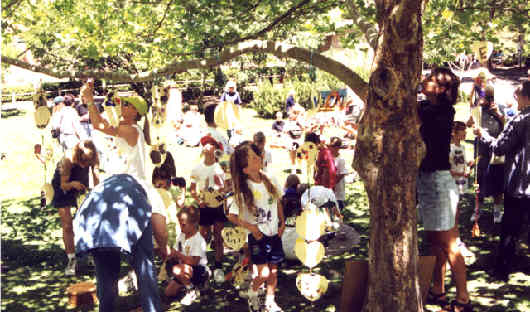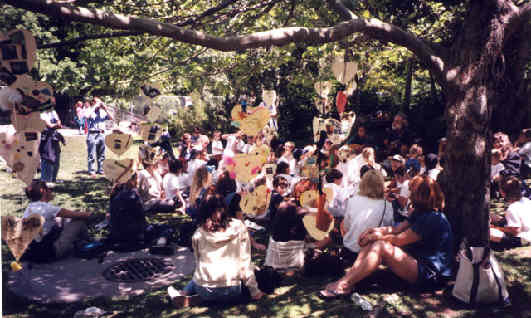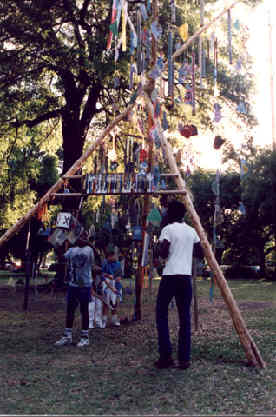Simplified for Everyone
Schools / Zoos Project
Please see the book - The Child Who Went to the Zoo
Introduction
Zoos and Aquariums attract tremendous numbers of visitors annually. They are where the vast majority of people have their only real contact with the 'natural' world. Zoos and Aquariums serve as metaphors for what is happening in the wild, i.e., more and more of the natural world is being hemmed in by and taken over as the result of human activity.
Zoos and Aquariums are doing some good in trying to maintain species on the brink of extinction and in helping to preserve some natural habitats. They are trying to educate the public about some of the threats to species survival.
However, when all is said and done, their basic philosophy, that it is alright to confine non-human species for educational/entertainment purposes, is terribly flawed. It only perpetuates the myth that humans are "the superior being" with the right to exercise their will over all other beings.
Zoos and Aquariums also fall far short in laying out to the public what must be done to save wild "habitats" (an interesting word used by biological science to disguise the real meaning of the word - "homes"). Very little is said at most Zoos/Aquariums about reducing human, domesticated animal, and pet population growth, or about lowering standards of living, or about mandating sweeping recycling and reuse programs, or about stopping the spending of billions of dollars on sending humans to Mars while we continue to trash the earth, etc.
The truth is that Zoos and Aquariums are immoral institutions and should, over time, be completely phased out of existence. In the meantime, those animals incarcerated and unable to fend for themselves in the wild should be moved to much larger spaces where they could at least have some privacy and some "room to roam".The Golden Rule, to treat others as we ourselves would like to be treated, needs to be extended to all things on this earth, and not just apply to Homo Sapiens. In short, Zoos and Aquariums need to become extinct , and in the meantime, be honest and up-front about sharing information with their visitors regarding the impacts humans are having on the earth (extinction rates in the wild are now estimated at 500 species per day lost).
This earth we all share is home to many things, with equal rights to "life, liberty, and the pursuit of happiness".We are enslaving the earth. A Ghandian effort will be required to bring justice to the "unspoken for".
Project Description - Goals
The Schools/Zoos Project has been created and is designed to accomplish the following:
-
Foster in young children an understanding, appreciation, sensitivity and compassion for the plight of animals in Zoos and Aquariums and their relatives in the wild.
-
Provide an outlet for children to "give something back" to the earth and to our non-human relations.
-
Develop lasting, intimate, and caring relationships between individuals (people and specific animals housed in Zoos and Aquariums).
-
Identify the impacts we, as individuals, are having on the "natural world".
-
Clarify for all visitors to Zoos and Aquariums what humans must do in terms of their own personal lives to reduce "habitat" loss and preserve the diversity of life on this earth.
Components
The Schools/ Zoos Project is a very simple, heart based program which can be almost immediately implemented by any school, with or without the co-operation of a local Zoo or Aquarium. It is your program, and although there have been some common threads among the beginning PROJECTS, some of which are enumerated below, you can make it out to be whatever you want it to be. You do not have to agree with our intention that Zoos/Aquariums be phased out of existence. Here are the basic elements common to the beginning programs:
-
Children make at least four visits to their local Zoo/Aquarium each school year.
-
At least two of these visits involve time for each child to sit with an adopted animal and observe and write about their times together.
-
Classroom and home study time is allocated for each child to study the nature of the adopted species in the wild and the threats to that species in the wild.
-
The story, The Child Who Went to the Zoo is read to the children in their classroom, and the exercises in the Appendix, specifically, the Where do things come from? section are studied.
-
In co-operation with the school's Art Teacher, works of art are created for the animals at the Zoo. These might be Valentines/Thankyou Cards for the Earth and/or Pinatas filled with food for the animals, both made from recycled/reused items.

Children hanging valentine/thankyou cards to the earth at the zoo
-
In co-operation with the school's Music Teacher, songs are written and rehearsed for serenading the animals.
-
At least one visit to the Zoo/Aquarium involves a ceremony wherein the Art and Musical gifts of the children are shared with the inhabitants of the Zoo/Aquarium. Parents are encouraged to participate in this special event.

Children serenading the animals at the zoo
-
A concerted effort is launched to better educate the children and all visitors to the Zoo/Aquarium about what we as individuals can do to help save the diversity of live on the earth and to change the nature of Zoos/Aquariums in general (this can take many different forms).
-
Specific programs are adopted at the school and/or at the Zoo/Aquarium to help mitigate the impacts humans are having upon the earth.
The musical harmony wind chime sculpture
graphically demonstrates the impacts of human population growth and natural resource consumption on the earth
Note: for further information on the SCHOOLS/ZOOS PROJECT, and specifically, information on specific Schools and Zoos participating, e-mail dickbozung@guitarsimplified.com or call 804-725-0355. We are available to come to your school and help you get started, and more specifically, help you conduct your first HARMONY CEREMONY at the Zoo/Aquarium.
We strongly encourage you not to go to circuses and theme parks that confine/exploit animals for entertainment purposes. Is it the way you would want to be treated? Think, for example of the free range of a whale and its interaction with other whales etc., and then look at the space and interaction level at a place like a Sea World. As a tiger in the circus, how would you like your little cage, being trucked all over the country, and whipped into submission to perform little tricks for masses of people stuffing their faces with junk food?
A First Step: Suggested Signage at Zoo Entrances
"To our BROTHER and SISTER ANIMALS at the Zoo: We are in awe of your beauty and diversity. We appreciate the sacrifices you are making so that we might come to better know each of you, and in turn, your wild relatives, and the problems confronting all wild creatures. We SEE that your situation here is a reflection of what is happening in the wild. We understand that our growing human popluation and appetite to consume the earth's resources are largely to blame. May you help us to SEE how we might CHANGE in order to preserve the diversity of life on this earth we all call home. Thank you."
• • •